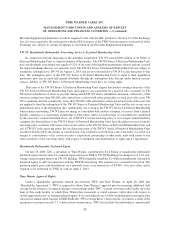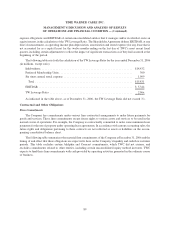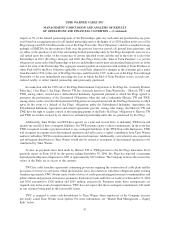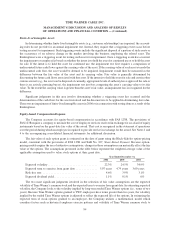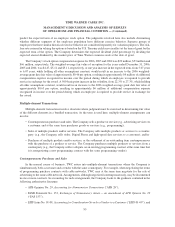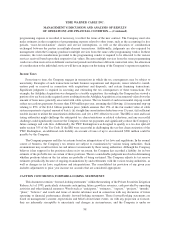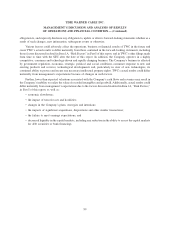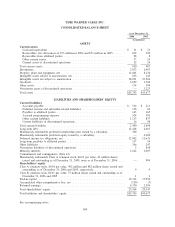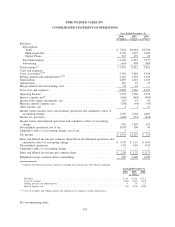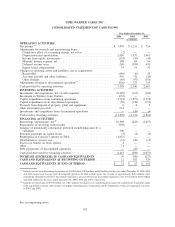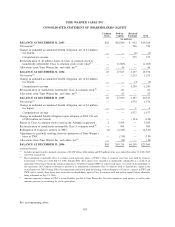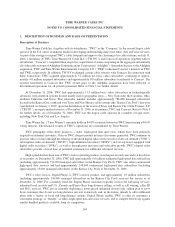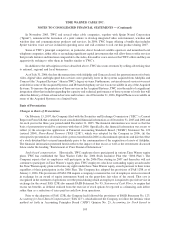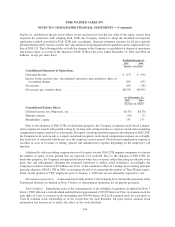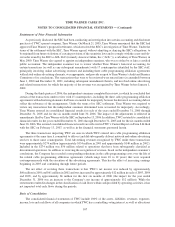Time Warner Cable 2006 Annual Report Download - page 102
Download and view the complete annual report
Please find page 102 of the 2006 Time Warner Cable annual report below. You can navigate through the pages in the report by either clicking on the pages listed below, or by using the keyword search tool below to find specific information within the annual report.or services, the Company evaluates whether it has fair value evidence for each product or service being purchased. If
the Company has fair value evidence for each product or service being purchased, it accounts for each separately,
based on the relevant cost recognition accounting policies. However, if the Company is unable to determine fair
value for one or more of the purchased elements, the Company would recognize the cost of the transaction on a
straight-line basis over the term of the agreement.
This policy also would apply in instances where the Company settles a dispute at the same time the Company
purchases a product or service from that same counterparty. For example, the Company may settle a dispute on an
existing programming contract with a programming vendor at the same time that it is renegotiating a new
programming contract with the same programming vendor. Because the Company is negotiating both the settlement
of the dispute and a new programming contract, each of the elements should be accounted for at fair value. The
amount allocated to the settlement of the dispute would be recognized immediately, whereas the amount allocated
to the new programming contract would be accounted for prospectively, consistent with the accounting for other
similar programming agreements.
Property, Plant and Equipment
TWC incurs expenditures associated with the construction of its cable systems. Costs associated with the
construction of the cable transmission and distribution facilities and new cable service installations are capitalized.
With respect to certain customer premise equipment, which includes converters and cable modems, TWC
capitalizes installation charges only upon the initial deployment of these assets. All costs incurred in subsequent
disconnects and reconnects are expensed as incurred. Depreciation on these assets is provided, generally using the
straight-line method, over their estimated useful lives.
TWC uses product-specific and, in the case of customers who have multiple products installed at once, bundle-
specific standard costing models to capitalize installation activities. Significant judgment is involved in the
development of these costing models, including the average time required to perform an installation and the
determination of the nature and amount of indirect costs to be capitalized. Additionally, the development of
standard costing models for new products such as Digital Phone involve more estimates than the standard costing
models for established products because the Company has less historical data related to the installation of new
products. The standard costing models are reviewed annually and adjusted prospectively, if necessary, based on
comparisons to actual costs incurred.
TWC generally capitalizes expenditures for tangible fixed assets having a useful life of greater than one year.
Types of capitalized expenditures include: customer premise equipment, scalable infrastructure, line extensions,
plant upgrades and rebuilds and support capital. For converters and modems, useful life is generally 3 to 4 years and
for plant upgrades, useful life is up to 16 years. In connection with the Transactions, TW NY acquired significant
amounts of property, plant and equipment, which were recorded at their estimated fair values. The remaining useful
lives assigned to such assets were generally shorter than the useful lives assigned to comparable new assets to reflect
the age, condition and intended use of the acquired property, plant and equipment.
Programming Agreements
The Company exercises significant judgment in estimating programming expense associated with certain
video programming contracts. The Company’s policy is to record video programming costs based on TWC’s
contractual agreements with programming vendors, which are generally multi-year agreements that provide for
TWC to make payments to the programming vendors at agreed upon rates, which represent fair market value, based
on the number of subscribers to which TWC provides the service. If a programming contract expires prior to
entering into a new agreement, the Company is required to estimate the programming costs during the period there
is no contract in place. The Company considers the previous contractual rates, inflation and the status of the
negotiations in determining its estimates. When the programming contract terms are finalized, an adjustment to
97
TIME WARNER CABLE INC.
MANAGEMENT’S DISCUSSION AND ANALYSIS OF RESULTS
OF OPERATIONS AND FINANCIAL CONDITION — (Continued)



